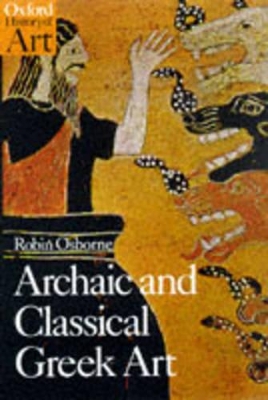Oxford History of Art
1 total work
This fascinating new account of what happened in Greece from c.800 to 323 bc shows how sculptors and painters responded to the challenges they faced in the extremely formidable and ambitious world of the Greek city-state. The numerous symbols and images employed by their eastern Mediterranean neighbours on the one hand, and the explorations of what it was to be human embodied in the narratives with which Greek poets worked on the other, helped produce the rich diversity of forms apparent in Greek art. The drawings and sculptures of this period referred so intimately to the human form as to lead both ancient and modern theorists to talk in terms of the 'mimetic' role of art. The importance of what occurred still affects the way we see today.
Ranging widely over the fields of sculpture, vase painting and the minor arts, this book provides a clear introduction to the art of archaic and classical Greece. By looking closely at the context in which and for which sculptures and paintings were produced, Robin Osborne demonstrates how artistic developments were both a product of, and contributed to, the intensely competitive life of the Greek city.
'brilliantly illustrates the purpose of this new series by focusing on the social and political context of Greek art . . . a different approach suggesting new perspectives and original connections . . . eye-opening and thought-provoking'
Professor François Lissarrague, Ecoles des Hautes Etudes en Sciences Sociales, Paris
'brings all that is best in the 'new' Classical art history to this exciting interpretation . . . No reader of Osborne's stimulating and engaging book will come away with their vision of Greek art unchanged'
Jeremy Tanner, Institute of Archaeology, University of London
Ranging widely over the fields of sculpture, vase painting and the minor arts, this book provides a clear introduction to the art of archaic and classical Greece. By looking closely at the context in which and for which sculptures and paintings were produced, Robin Osborne demonstrates how artistic developments were both a product of, and contributed to, the intensely competitive life of the Greek city.
'brilliantly illustrates the purpose of this new series by focusing on the social and political context of Greek art . . . a different approach suggesting new perspectives and original connections . . . eye-opening and thought-provoking'
Professor François Lissarrague, Ecoles des Hautes Etudes en Sciences Sociales, Paris
'brings all that is best in the 'new' Classical art history to this exciting interpretation . . . No reader of Osborne's stimulating and engaging book will come away with their vision of Greek art unchanged'
Jeremy Tanner, Institute of Archaeology, University of London
